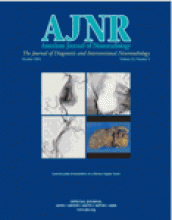Abstract
Summary: We report the clinical and radiologic features of a 31-year-old woman who suffered incongruous binasal and bitemporal visual field defects and severe sudden visual loss due to hypoperfusion of bilateral lateral geniculate bodies following anaphylactic shock induced by 500 mg amoxicillin per os. Complete neuroophthalmologic examinations were performed regularly for visual acuity, color vision, pupillary reflexes, and visual fields. Additional testing was performed by means of MR imaging of the brain and CSF analysis. Follow-up was performed for 12 months. Vision loss was acute and severe, its onset bilateral and simultaneous. The patient recovered visual acuity of 1.0 within 7 weeks. Color vision was abnormal in both eyes but gradually improved to normal. Visual fields were characterized by incongruous binasal and bitemporal defects, but they reduced progressively. Cerebral MR imaging confirmed the presence of symmetrical lesions confined exclusively within both lateral geniculate bodies. These lesions were best seen on T1-weighted and fluid-attenuated inversion recovery images as high-signal-intensity areas suggestive of hemorrhagic ischemia. CSF analysis was normal and aseptic. Blood tests and cultures excluded any microbial infection. We conclude that shock may induce a bilateral isolated ischemia of the lateral geniculate bodies, resulting in incongruous binasal and bitemporal visual field defects and severe visual loss. MR imaging is the optimal imaging technique to confirm the diagnosis and for follow-up.
- Copyright © American Society of Neuroradiology












